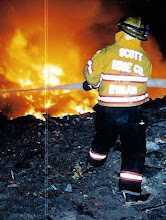Gary Ryman, Author of “Fire Men: Stories From Three Generations of a Firefighting Family”
August 28, 2012 — Pat Bertram What is your book about?
What is your book about?Fire Men: Stories From Three Generations of a Firefighting Family relates the experiences as firefighters of my father, myself, and my son. As both the son and father of firefighters, I bring a different perspective. Having the opportunity to fire fires, with both my father and my son as well as respond to auto accidents, and the myriad other emergencies that fire departments handle was marvelous.
How long had the idea of your book been developing before you began to write the story?
I can’t say it really started in my mind as a book. I began writing out the stories of individual emergency calls with the thought that perhaps sometime in the future the vignettes might be of interest to my son or daughter or perhaps a future generation. After I had a hundred plus pages of this material, it dawned on me that perhaps this was a book trying to get out.
How long did it take you to write your book?
About four years from pen touching paper to holding the first printed copy. The first draft took just over a year. It wasn’t remotely ready, but I didn’t know that at the time, and with the encouragement of some friends, I began the querying process. One of the agents I wrote had represented an author I liked a great deal. A few weeks after sending my letter, I received an email from another agent at that firm indicating that the first agent was not interested; but that my query had intrigued her and she wanted to read the manuscript. After reading it, she agreed to work with me and provided incredibly valuable feedback and suggestions which I incorporated in a second draft. A few more rounds of revisions followed and just before she was ready to start sending the manuscript out, I was orphaned—she left to take a job as an editor at one of the big six houses. Not surprisingly, the agent she passed the manuscript who decided it wasn’t for him, and so I was back to square one, albeit with a much improved book. This time, along with agents, I looked at small publishers as well, and was lucky enough to hook up with a wonderful publisher, Tribute Books http://www.tribute-books.com/ They have since transitioned to YA books, but continue to strongly support their entire list, and have been just fantastic to work with.
What is your goal for the book, ie: what do you want people to take with them after they finish reading the story?
For many, whom the closest they have ever been to a fire truck is when it passes them on the roadway, I hope they get an understanding of what firefighting is really like. The mental and physical challenges, along with the emotional aspects of the job are not usually apparent to the general public. In addition to those, the family facets lend an important component. While I worked with my father and son, I also had many brothers; fellow firefighters who you trust with your life. For those in the fire service, the greatest compliments I receive are those that read it and say “yeah, that’s exactly how it is.”
What are you working on right now?
I just submitted my thesis for my Masters in American History. That has been consuming me for most of the past nine months. Now I hope to return to the novel I began shortly after publication of “Fire Men” which is an action adventure genre work, naturally set in a fire department. A Lieutenant dies while battling a fire which was deliberately set in an insurance fraud scheme and his best friend and brother-in-law who leads a ladder company in the same department searches for the arsonist.
What do you like to read?
I read mainly history or action/adventure.
Where do you get the names for your characters?
When I wrote the book, I used real names to allow me to keep track of people and try to ensure I captured their personalities. In the revision process, though, the majority of the names had to be changed. I stole an idea from a writer’s seminar I attended, and bought a baby name book, and reworked the names from that.
If your book was made into a TV series or Movie, what actors would you like to see playing your characters?
While I can’t say for everyone in the book, I would certainly be willing to settle for being played by Brad Pitt. The resemblance (not) is so close!
Who designed your cover?
The publisher took care of the cover, and I think did an incredible job. I was stunned the first time I saw it, and could not have been happier.
Where can people learn more about your books?
 Folks can visit my website for more information. The book is also available in paperback on Amazon.com as well as Barnes & Noble and in virtually all e-book formats.
Folks can visit my website for more information. The book is also available in paperback on Amazon.com as well as Barnes & Noble and in virtually all e-book formats.http://fire-men-book.blogspot.com/
http://www.amazon.com/gp/product/0982256590/ref=s9_simh_gw_p14_d0_i1?pf_rd_m=ATVPDKIKX0DER&pf_rd_s=center-2&pf_rd_r=0CM4CBCA5H4DWQXT1Y38&pf_rd_t=101&pf_rd_p=1389517282&pf_rd_i=507846
http://www.barnesandnoble.com/w/fire-men-gary-r-ryman/1100719030?ean=9780982256596
http://patbertram.wordpress.com/2012/08/28/gary-ryman-author-of-fire-men-stories-from-three-generations-of-a-firefighting-family/#comment-2906




